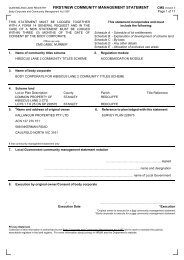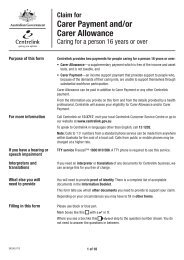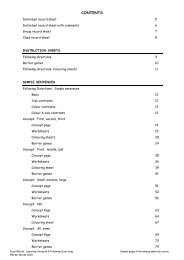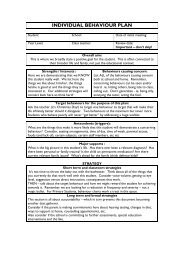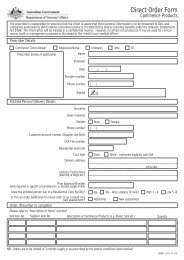Understanding rural landholder responses to climate change
Understanding rural landholder responses to climate change
Understanding rural landholder responses to climate change
- No tags were found...
Create successful ePaper yourself
Turn your PDF publications into a flip-book with our unique Google optimized e-Paper software.
Furthermore, while some external exposures and adaptive capacity determinants willbe common <strong>to</strong> individual landholdings, the property location and characteristics ofindividual <strong>landholder</strong>s can vary greatly. Consequently, vulnerability <strong>to</strong> <strong>climate</strong> <strong>change</strong>can vary considerably across a region. This variation means that an agriculturalsystem‟s vulnerability will be determined by aggregate condition oflandholding/farms in that region.2.4: Clarification of termsLanguage is an important part of environmental discourse – it is part of theconstruction, interpretation, discussion and analysis of conversations (Dryzek 1997).Dialogue about the phenomenon of the warming of the Earth‟s <strong>climate</strong>, implicationsof that warming, and required <strong>responses</strong> <strong>to</strong> those <strong>change</strong>s has been variously andsometimes inter<strong>change</strong>ably referred <strong>to</strong> as „global warming‟, „<strong>climate</strong> <strong>change</strong>‟, or„<strong>climate</strong> variability‟.Climate variability has been defined as irregular patterns or extreme conditions, suchas more frequent droughts, or deviations from normal growing season conditions(Smit and Skinner 2002). The Intergovernmental Panel on Climate Change (IPCC)defines <strong>climate</strong> <strong>change</strong> as any <strong>change</strong> in <strong>climate</strong> over time whether due <strong>to</strong> naturalvariability or resulting from human activity. This usage differs from that in the UnitedNations Framework Convention on Climate Change (UNFCCC), where <strong>climate</strong><strong>change</strong> refers <strong>to</strong> <strong>change</strong> that is attributed <strong>to</strong> human activity that alters the compositionof the global atmosphere and that is in addition <strong>to</strong> natural <strong>climate</strong> variability observedover comparable time periods (IPCC 2007). In this research we have followed theinterpretation of the UNFCCC in our use of the term „<strong>climate</strong> <strong>change</strong>‟. While <strong>climate</strong>variability is a feature of the Australian experience, modelling suggests that „<strong>climate</strong><strong>change</strong>‟ will increase that variability (DSE 2008b).Other climatic phenomena like „drought‟ have also been challenging <strong>to</strong> define. Someargued earlier this decade that „drought‟ needed <strong>to</strong> be recognised as a complex but„normal‟ part of Australian agriculture – a consequence of a highly variable <strong>climate</strong>and should be referred <strong>to</strong> as part of „<strong>climate</strong> variability‟ (Botterill and Fisher 2003;Lindesay 2003). Recent national dialogues position „drought‟ as something that willbe affected by „<strong>climate</strong> <strong>change</strong>‟ – with a projected two-fold increase in theirfrequency and severity (Hennessy et al. 2008). The current National Drought Policy isbeing reviewed with a view <strong>to</strong> better preparing farmers, <strong>rural</strong> communities andAustralia‟s primary industries for the challenges of „<strong>climate</strong> <strong>change</strong>‟ (MAFF 2008).This review signals a policy shift from treating drought and <strong>climate</strong> <strong>change</strong> separatelyand a movement <strong>to</strong>wards linking drought preparedness and <strong>climate</strong> <strong>change</strong> adaptation(Milne et al. 2008). In this research, the term „<strong>climate</strong> variability‟ refers <strong>to</strong> theexperience of <strong>landholder</strong>s of past and current variations or trends in <strong>climate</strong>, including„drought‟.Lorenzoni et al. (2006) suggested that the shift from the term „global warming‟ <strong>to</strong>„<strong>climate</strong> <strong>change</strong>‟ was part of a strategy by sceptics <strong>to</strong> neutralise the seriousness of thephenomenon. Similarly, previous research in the NCCMA region (McDonald et al.2006) found <strong>climate</strong> <strong>change</strong> <strong>to</strong> be both poorly unders<strong>to</strong>od and a highly politicisedterm implying allegiance <strong>to</strong> a particular political party or way of thinking. Regardlessof how „<strong>climate</strong> <strong>change</strong>‟ is perceived by scientists, individual perceptions of itsmeaning are likely <strong>to</strong> relate more <strong>to</strong> the public discourse than the science. In framingthis research we acknowledged that „<strong>climate</strong> <strong>change</strong>‟ is not generally seen in terms of6




